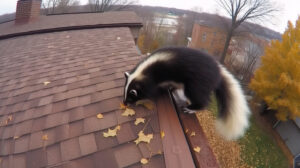Baby skunks are most well-known for their stinky spray, but that’s not the most interesting thing about them! Did you know that they are in their own scientific family? What about the fact their spray isn’t in unlimited supply?
Keep reading to learn what a baby skunk is called and four more interesting facts!
#1: Baby Skunks are Called Kits!
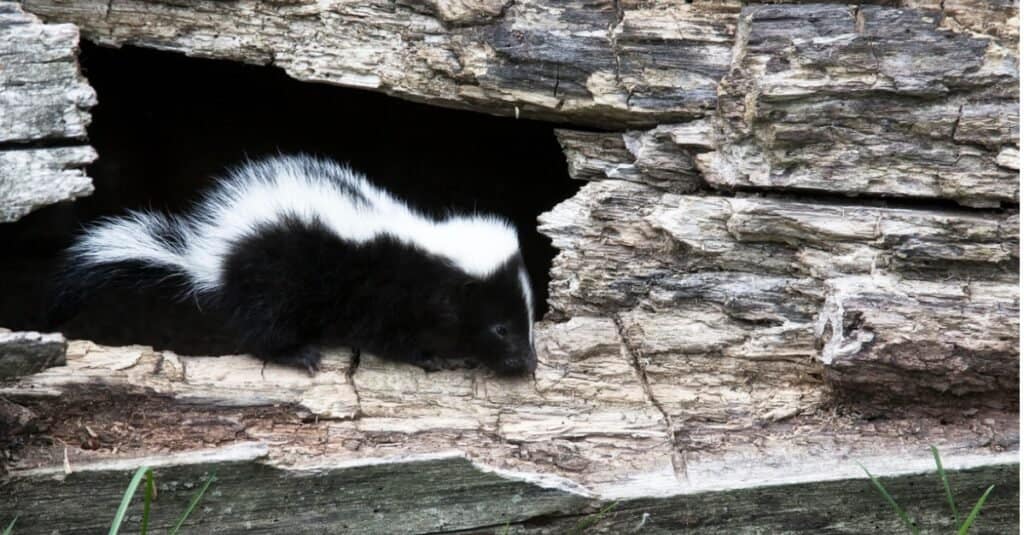
Skunk babies are called kits.
©iStock.com/Lynn_Bystrom
A baby skunk is called a kit! Much like human babies are called infants and baby dogs are called puppies, baby skunks also have a special name. Baby skunks are called kits! But they’re not the only animal on Earth with this name. Here are a few other baby animals that are called kits:
- Ferret
- Fox
- Rabbit
- Raccoon
#2: Skunk Kits are Born Blind and Toothless
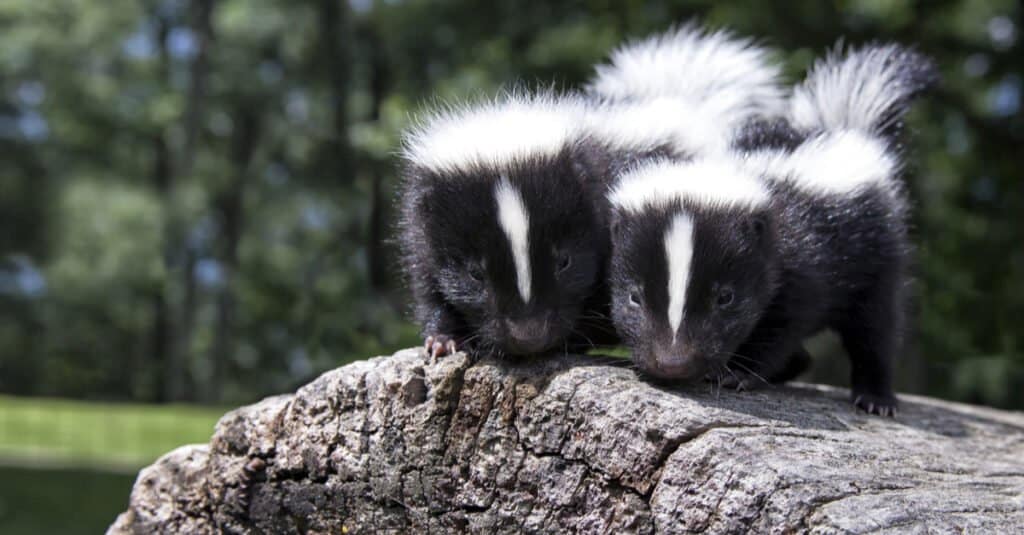
Skunk kits depend on their mother to protect them as newborns.
©critterbiz/Shutterstock.com
Newborn baby skunks are completely dependent on their mother for survival. Since they are mammals, they must have their mother’s milk for one to two months for nourishment. Since they don’t have teeth, they can’t consume any other type of food.
Baby skunks are born with their eyes shut and won’t open them until they are around 3 weeks old. Luckily, they have an excellent sense of smell, which is what they use to find their mothers. Female skunks are incredibly protective of their young. Any time a threat is near her babies, a mother skunk will stomp and hiss to warn them.
While a mother skunk can use a stinky spray to scare off predators, newborn skunk kits cannot. The scent glands that are used to discharge the defensive spray aren’t fully developed until the kits are around three months old. Even once they can use them, skunk babies choose not to unless they are in grave danger.
Skunks exclusively use their spray to protect themselves from danger. A few of a skunk kit’s most common predators are owls, foxes, hawks, and coyotes.
#3: Skunk Babies Become Independent at One Year Old!
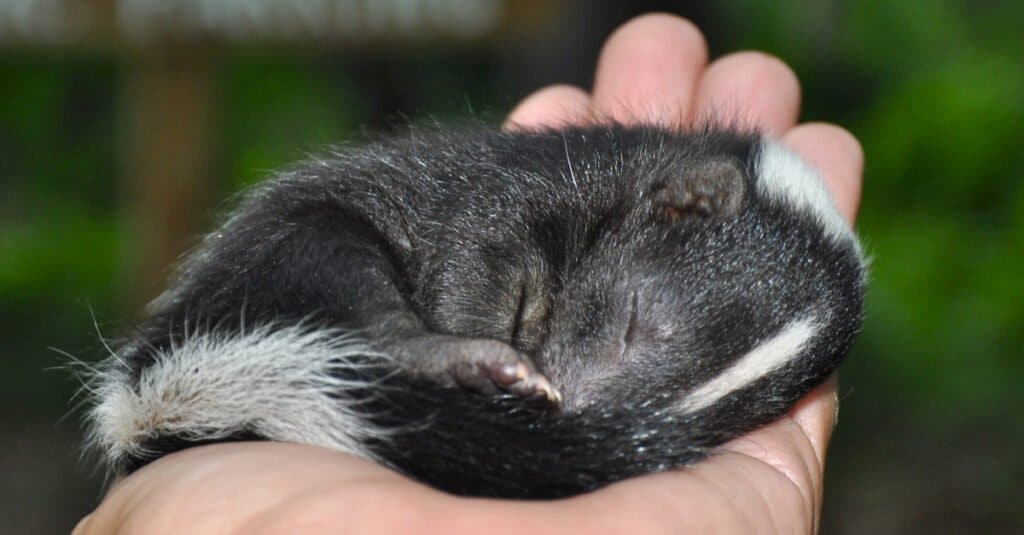
Skunks can fend for themselves at just one year old!
©Becky Sheridan/Shutterstock.com
It’s crazy to imagine a baby surviving on its own at just one year old. However, for skunk kits, this is a reality. Once they are weaned from their mother’s milk, able to forage for food on their own and understand how to protect themselves, they’re ready for independence.
Most skunk kits successfully journey away from their mothers around ten to twelve months of age. At this age, they are also completely sexually mature, so they’re even ready to go off and have their babies! Female skunks go on to have a litter of kits about once a year on average.
But how many babies can a skunk have at once? Typically, litters consist of about four to seven baby skunks.
The gestation period of a skunk is about sixty days and nearly all skunk litters are born in the spring, between April and May. Even though it’s less common, a few stragglers can be born in early June. Since older female skunks are ready to mate earlier in the season, they usually have their babies first. Older females are also more likely to have large litters versus young skunks.
Skunks are polyandrous, which means that a single male skunk is likely to be responsible for many litters. Sometimes, a female skunk will reject a male’s mating proposal. When this happens, she will produce a stink that emanates from her body. This tells the male skunk to find another mate. Though a skunk spray smell can last weeks, the odor produced to reject mating usually only lasts a few days and is less offensive in smell.
#4: Skunk Kits are in their Own Scientific Family!
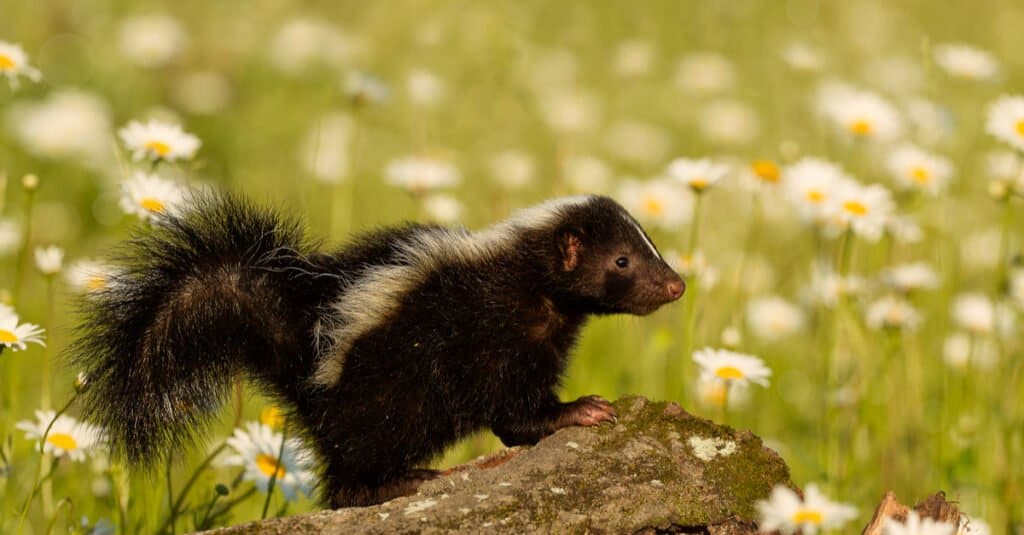
Skunk kits have a family all their own.
©Agnieszka Bacal/Shutterstock.com
Scientists once believed that skunk kits were in the Mustelid family. This meant that they were thought to be related to badgers, otters, and weasels. However, in the 1990s, scientists analyzed skunk molecules, which revealed the skunk’s classification was not correct.
The molecular analysis revealed that skunks should be classified under their own family. They were renamed Mephitidae, a family that only includes four species of skunks and stink badgers. This exclusive family is made up of hog-nosed skunks, spotted skunks, hooded/striped skunks, and stink badgers. Now, that’s a stinky family!
#5: Baby Skunks Have a Limited Supply of Spray
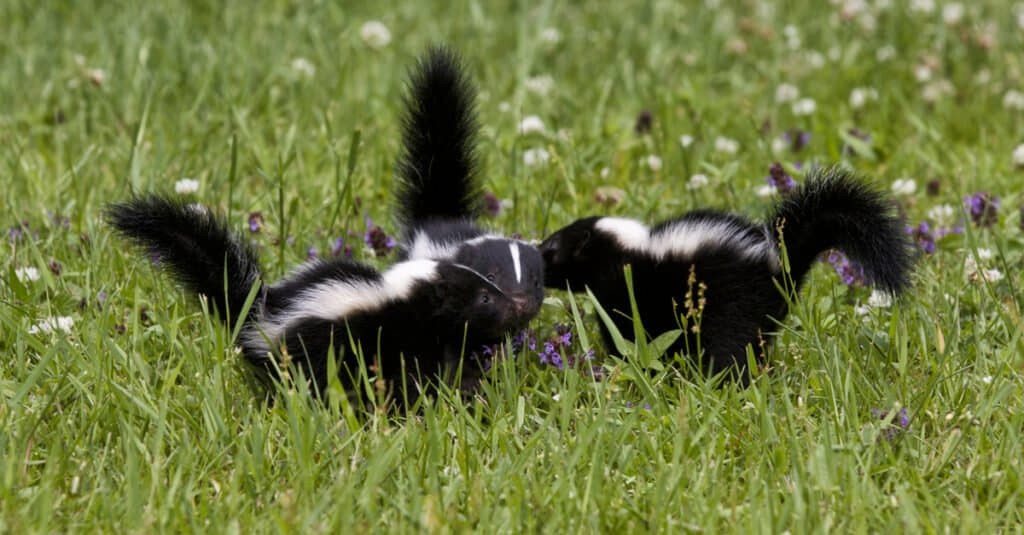
It takes about ten days for skunk babies to regenerate their spray.
©Debbie Steinhausser/Shutterstock.com
Skunks are arguably most famous for the oily, stinky spray they omit when threatened. To protect themselves from predators, they can emit this spray up to 10 feet away.
When gearing up to spray, a baby skunk will do a handstand with its tail facing the predator. While the spray is unharmful, the stench can last several days. However, this is not in an unlimited supply.
You might be surprised to learn that baby skunks use their spray as sparingly as possible. This is because they can only store enough material for five or six sprays at a time. After this, they must wait a long time to be able to use their spray again. Usually, it takes a minimum of ten days to regenerate the substances needed to spray again.
The photo featured at the top of this post is © critterbiz/Shutterstock.com
FAQs (Frequently Asked Questions)
What are baby skunks called?
Baby skunks are called kits. A group of baby skunks is called a litter. Skunks share the name kit with many other baby animals like foxes and chinchillas.
How much do baby skunks weigh?
When baby skunks are born, they weigh a tiny one ounce! They are also hairless, have their eyes closed, and have no teeth.
What do baby skunks eat?
Skunk kits are mammals, which means they have live births and survive on their mother’s milk as infants. For the first two months, skunk kits only drink their mother’s milk. Once weaned, they transition to an omnivorous diet. Some of a skunk’s favorite foods are bees,
Where do baby skunks live?
Baby skunks live in areas of South and North America.
Thank you for reading! Have some feedback for us? Contact the AZ Animals editorial team.




